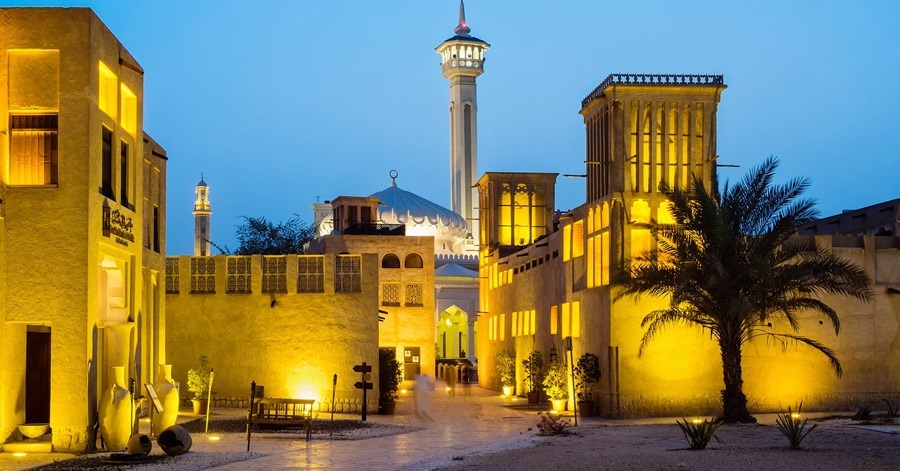Al Fahidi (Bastakiya): Dubai’s Historic District
Nestled along the banks of Dubai Creek, Al Fahidi Historical District, also known as Bastakiya, offers a fascinating glimpse into Dubai’s past. Unlike the city’s towering skyscrapers and lavish developments, this district takes visitors back in time with its narrow lanes, wind-tower architecture, and heritage buildings. Al Fahidi is a beautifully preserved area that celebrates Dubai’s history, culture, and traditional way of life.
In this blog, we’ll explore the charm of Al Fahidi, from its architecture and cultural sites to the art galleries and cafés that now thrive within the historic quarter.
1. The Origins of Al Fahidi
Al Fahidi was built in the late 19th century by Persian merchants who settled along Dubai Creek. These merchants, many of whom came from the Bastak region of Iran, gave the district the name “Bastakiya.” The area grew as a trading hub for pearls, spices, and textiles, establishing itself as a key part of Dubai’s economy.
The unique wind-tower (barjeel) architecture found throughout the district was designed to naturally cool homes in the hot desert climate, showcasing the region’s innovative approach to architecture long before air conditioning was invented.
2. Architecture and Urban Layout
Al Fahidi is a labyrinth of narrow alleys and courtyards, with sand-colored houses built using coral, gypsum, and mud bricks. The area’s defining feature is the wind towers, which catch breezes and direct them into homes to keep the interiors cool.
Unlike the glitz of modern Dubai, the beauty of Al Fahidi lies in its simple elegance and the sense of history that permeates the streets. Strolling through the alleys, visitors can experience a side of Dubai that contrasts sharply with the city’s futuristic developments.
3. Art and Culture Hub
In recent years, Al Fahidi has transformed into a cultural and artistic center, attracting both locals and tourists.
- Alserkal Cultural Foundation: Located within a traditional house, this venue hosts art exhibitions, workshops, and cultural events.
- XVA Art Hotel & Café: A boutique hotel, art gallery, and café all in one, XVA is a favorite spot for art enthusiasts and offers a serene escape from the bustling city.
- Mawaheb Art Studio: A unique art studio that provides opportunities for artists with special needs to showcase their talents, adding to the district’s inclusive atmosphere.
4. Must-Visit Attractions in Al Fahidi
Al Fahidi is home to several key attractions that offer insight into the city’s history and traditions:
- Dubai Museum (located in Al Fahidi Fort): Housed in the oldest building in Dubai, the museum showcases Dubai’s transformation from a small fishing village to a global metropolis.
- Sheikh Mohammed Centre for Cultural Understanding (SMCCU): This center offers visitors an opportunity to learn about Emirati customs, traditions, and Islamic culture through tours, lectures, and traditional meals.
- Coffee Museum: Coffee lovers can explore the history of coffee in the Middle East, with a collection of antique coffee pots and demonstrations of brewing methods.
5. Traditional Souks and Shopping
A short walk from Al Fahidi leads to traditional souks that have been part of Dubai’s trading heritage for decades:
- Textile Souk: Browse through a variety of fabrics, silks, and pashminas in this bustling market.
- Old Souk: This market specializes in handicrafts, spices, and souvenirs, offering authentic items that reflect the region’s heritage.
Shopping here provides visitors with an authentic experience far removed from the glitzy malls of modern Dubai.
6. Dining and Cafés in Al Fahidi
After exploring the cultural sites, visitors can relax at one of the district’s charming cafés and restaurants. Many offer traditional Emirati cuisine or international fusion dishes in a serene, courtyard setting.
- Arabian Tea House: A popular spot for locals and tourists alike, known for its delicious traditional dishes and tranquil garden seating.
- Local House Restaurant: Famous for serving camel burgers, this restaurant offers a unique dining experience with a taste of Emirati tradition.
These establishments provide the perfect atmosphere to unwind after a day of exploring.
7. Events and Festivals
Al Fahidi plays host to several cultural events throughout the year, including:
- Sikka Art Festival: An annual art event that showcases local talent through exhibitions, installations, and live performances.
- Dubai Heritage Week: A celebration of Emirati culture, featuring traditional music, dance, and food.
These events breathe new life into the district, attracting a diverse crowd and celebrating the region’s artistic and cultural heritage.
8. Why Visit Al Fahidi?
Al Fahidi offers an authentic experience that reveals a different side of Dubai—a side that values heritage, art, and culture. The district is ideal for:
- History lovers seeking to understand Dubai’s origins.
- Art enthusiasts exploring galleries and cultural centers.
- Travelers looking for unique shopping and dining experiences.
While modern Dubai dazzles with skyscrapers and luxury, Al Fahidi stands as a symbol of the city’s past—a reminder of how far the city has come.
Conclusion: Where Old Meets New
Al Fahidi Historical District is a must-visit destination for anyone seeking to explore the cultural heart of Dubai. Whether you’re wandering through its narrow lanes, sipping coffee in a hidden courtyard, or admiring the wind-tower architecture, Al Fahidi offers a journey through time that highlights the city’s humble beginnings.
This charming district provides a refreshing break from the modernity of Dubai, inviting visitors to experience the city’s heritage in a relaxed and peaceful setting. As the bridge between Dubai’s past and present, Al Fahidi is truly a cultural gem worth exploring.


0 Comment